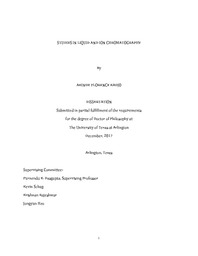
ATTENTION: The works hosted here are being migrated to a new repository that will consolidate resources, improve discoverability, and better show UTA's research impact on the global community. We will update authors as the migration progresses. Please see MavMatrix for more information.
Show simple item record
| dc.contributor.advisor | Dasgupta, Purnendu K. | |
| dc.creator | Kadjo, Akinde Florence | |
| dc.date.accessioned | 2018-02-15T19:42:29Z | |
| dc.date.available | 2018-02-15T19:42:29Z | |
| dc.date.created | 2017-12 | |
| dc.date.issued | 2017-11-30 | |
| dc.date.submitted | December 2017 | |
| dc.identifier.uri | http://hdl.handle.net/10106/27147 | |
| dc.description.abstract | Height- and area-based quantitation approaches reduce two-dimensional data to a single value. For a calibration set, there is a single height- or area-based quantitation equation. We introduce a new quantitation method; a Width based method that consists of using the width of a peak (Wh), at any height h, (a fixed height, not a fixed fraction of the peak maximum), leading to any number of calibration curves. This particularity of width-based quantitation (WBQ) allows the quantitation of peaks over very large scales, making the quantitation of truncated peaks possible. We showed that WBQ can offer superior overall performance (lower root mean square relative error over the entire range) compared to area- or height-based linear regression methods, rivaling weighted linear regression, provided that response is uniform near the height used for width measurement. WBQ forces one to not ignore the 2-dimensionality of a peak and all of the information from the peak one can obtain; which allows the detection and quantitation of impurity down to 1% of impurity. | |
| dc.format.mimetype | application/pdf | |
| dc.language.iso | en_US | |
| dc.subject | Width | |
| dc.subject | Quantitation | |
| dc.subject | Calibration | |
| dc.subject | Impurity | |
| dc.title | Studies in Liquid and Ion Chromatography | |
| dc.type | Thesis | |
| dc.degree.department | Chemistry and Biochemistry | |
| dc.degree.name | Doctor of Philosophy in Chemistry | |
| dc.date.updated | 2018-02-15T19:44:37Z | |
| thesis.degree.department | Chemistry and Biochemistry | |
| thesis.degree.grantor | The University of Texas at Arlington | |
| thesis.degree.level | Doctoral | |
| thesis.degree.name | Doctor of Philosophy in Chemistry | |
| dc.type.material | text | |
| dc.creator.orcid | 0000-0002-2718-6023 | |
Files in this item
- Name:
- KADJO-DISSERTATION-2017.pdf
- Size:
- 9.914Mb
- Format:
- PDF
This item appears in the following Collection(s)
Show simple item record


